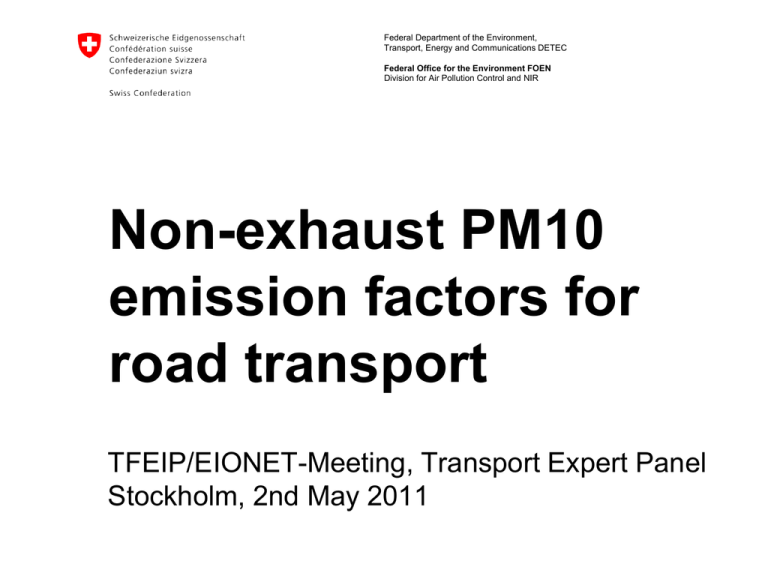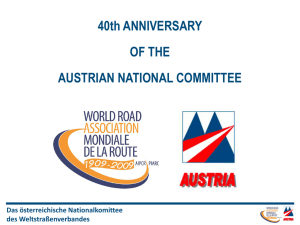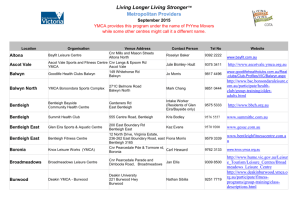Non-exhaust PM10 emission factors for road transport
advertisement

Federal Department of the Environment, Transport, Energy and Communications DETEC Federal Office for the Environment FOEN Division for Air Pollution Control and NIR Non-exhaust PM10 emission factors for road transport TFEIP/EIONET-Meeting, Transport Expert Panel Stockholm, 2nd May 2011 Overview • Development of PM10-Emissions by Transport in Switzerland • Examples of recent studies • Results of Swiss APART-Study • Comparison with Guidebook 2009 • Conclusion Non-exhaust PM10 emission factors for road transport| TFEIP/EIONET Meeting Stockholm 2nd May 2011, Transport Expert Panel Dr. Sophie Hoehn, Federal Office for the Environment FOEN, Division for air pollution control and NIR 2 Development of transport related PM10-emissions in Switzerland 5000 4500 4000 3500 t/a 3000 PM10 non-exhaust PM10 exhaust 2500 2000 1500 1000 500 0 1990 1995 2000 2005 2010 2015 2020 2025 2030 2035 Non-exhaust PM10 emission factors for road transport| TFEIP/EIONET Meeting Stockholm 2nd May 2011, Transport Expert Panel Dr. Sophie Hoehn, Federal Office for the Environment FOEN, Division for air pollution control and NIR 3 Exemples of recent studies • Switzerland: Abrasion PArticles produced by Road Traffic (APART) 2009 • Germany: Reifenabrieb in Feinstaub, 2009 • Sweden: Nanowear (2009), WEAREM (2009) Non-exhaust PM10 emission factors for road transport| TFEIP/EIONET Meeting Stockholm 2nd May 2011, Transport Expert Panel Dr. Sophie Hoehn, Federal Office for the Environment FOEN, Division for air pollution control and NIR 4 Results of APART-Studie Sources of non-exhaust PM10 in Switzerland: • Brake wear important on inner urban streets • Road surface wear rather negligible (no studded tyres) • Tyre wear negligible, > PM10 • Resuspension is very important • Important differences between inner urban streets and highways Non-exhaust PM10 emission factors for road transport| TFEIP/EIONET Meeting Stockholm 2nd May 2011, Transport Expert Panel Dr. Sophie Hoehn, Federal Office for the Environment FOEN, Division for air pollution control and NIR 5 Results of APART-Studie Non-exhaust PM10 emission factors for road transport| TFEIP/EIONET Meeting Stockholm 2nd May 2011, Transport Expert Panel Dr. Sophie Hoehn, Federal Office for the Environment FOEN, Division for air pollution control and NIR 6 Results of APART-Studie Non-exhaust PM10 emission factors for road transport| TFEIP/EIONET Meeting Stockholm 2nd May 2011, Transport Expert Panel Dr. Sophie Hoehn, Federal Office for the Environment FOEN, Division for air pollution control and NIR 7 Comparision with Guidebook 2009 Guidebook 2009 APART Inner urban main road APART Highway > PM10 > PM10 0.008 (± 0.004) 0.0016 (± 0.0011) < 0.003 n.a. > PM10 ! > PM10 0.081 (± 0.039) 0.009 (± 0.007) 0.007 n.a. Passenger Cars (g/km) Tyre wear Brake wear Road surface wear } 0.0138 0.0075 Heavy Duty Vehicles (g/km) Tyre wear Brake wear Road surface wear } 0.0590 0.0380 APART: considerable uncertainties were introduced by splitting the fleet emission factors into vehicle type specific emission factors. Non-exhaust PM10 emission factors for road transport| TFEIP/EIONET Meeting Stockholm 2nd May 2011, Transport Expert Panel Dr. Sophie Hoehn, Federal Office for the Environment FOEN, Division for air pollution control and NIR 8 Conclusion • Guidebook 2009 emissions factors are probably to high concerning road wear in general and brake/tyre wear for interurban roads • An update of the guidebook emission factors for non-exhaust PM10 should be considered • The introduction of emission factors for resuspended particles should be considered. • Specific emission factors for inner urban and interurban roads should be considered. Non-exhaust PM10 emission factors for road transport| TFEIP/EIONET Meeting Stockholm 2nd May 2011, Transport Expert Panel Dr. Sophie Hoehn, Federal Office for the Environment FOEN, Division for air pollution control and NIR 9

